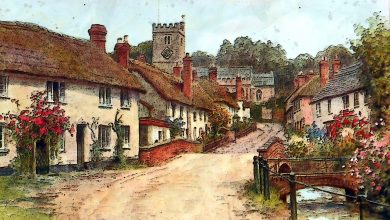The Garden of Love is a short lyric written by William Blake, one of the most popular poets of the Romantic age. First published in 1794, this poem formed a part of Blake’s collection of poetry Songs of Experience which is the complementary book to his Songs of Innocence presenting the corruption and repression prevalent in the world of adults as against the innocent world of childhood. As in the other poems of this collection, in this poem too, Blake expresses his perspective upon the despotism and repressive morality imposed by the institutionalized religion, and how it seems to control and suppress all forms of natural desires and passions. Blake’s poem “The Echoing Green”, and to a certain extent, “The Nurse’s Song” are this poem’s “pair” in the Songs of Innocence and aims to show that experience drowns the innocence of life, giving
A true Romantic at heart, Blake believed that love should not be sanctified by religion and should instead be allowed the freedom to grow and prosper without any inhibitions and restrictions. Quite unorthodox in his views, he rebelled against the orthodox morality of the church and thought that love, sexuality and passion are instinctive to man and should therefore not be considered as sin. These forces, which are holy and pure, are tainted as being forbidden by religion, which in Blake’s opinion should be less about rules and restrictions and more about joy, freedom and love.
This poem can also be seen as Blake’s statement against the idea of the original sin according to which man was expelled out of heaven as a punishment for succumbing to desire. He believes that the laws and strict code of conduct enforced by the priests, the church and even the holy texts such as the Ten Commandments, exist without any rationale. They are against the basic nature of humanity and should therefore be moulded and re-shaped to allow the positive forces of love and passion to flow freely.
The Garden of Love | Summary
The Garden of Love | Summary Lines 1-4
I went to the Garden of Love,
And saw what I never had seen:
A Chapel was built in the midst,
Where I used to play on the green.
Revisiting the Garden of Love, the place where he used to play when he was a child, the poet comes across an unexpected sight, one which he had never seen coming. A Chapel was built right in the middle of this green, open space where he used to play in without any care or reservations. But now, this beautiful place has lost that carefree air as the spirit of freedom seems to be caged amidst the rigid walls of the holy institution that had replaced his childhood playground.
The Garden of Love | Summary, Lines 5-8
And the gates of this Chapel were shut,
And ‘Thou shalt not’ writ over the door;
So I turn’d to the Garden of Love,
That so many sweet flowers bore.
The gates of this church are closed, which is unusual because the doors of God should be open and welcoming instead of being shut to the visitors. Moreover, the door bears a forbidding message which reads “Thou shalt not”, suggestive of the Ten Commandments from the Old Testament. He turns away from these prohibitions and restrictions, seemingly imposed by the authoritative religion. Seeking repose from such symbols of confinement, he goes back to the garden in search of the beautiful flowers that bloomed therein, filling the air with their sweet fragrance.
The Garden of Love | Summary, Lines 9-12
And I saw it was filled with graves,
And tomb-stones where flowers should be:
And Priests in black gowns, were walking their rounds,
And binding with briars, my joys & desires.
However, the poet discovers that the garden has undergone a drastic change, and not for the better. Where earlier there were blooming flowers, the symbols of life and joy; now all that can be seen are graves. Tomb-stones have replaced the sweet-smelling flowers just like the Church’s oppressive condemnation of free thought has superseded the vital forces of passion and love. The garden, which during his childhood was full of happy vibes, now reeks of misery and death. Amidst this garden, priests can be seen taking their rounds, maybe keeping a vigil over both the living and the dead, ready to condemn all sins. As opposed to the usual white robes which emanate peace and acceptance, they don black gowns, symbolic of mourning as well as their absolutist principles and morality that frowns upon the feelings of love and desire. They are completely devoid of all compassion and demand strict adherence to the rules and laws laid down by the church, regardless of them being restrictive of an individual’s freedom of spirit. They use sharp, thorny branches to restrain the poet who has come looking for gaiety and pleasure in the Garden of Love, against the commandments of their religion.
The Garden of Love | Analysis
“The Garden of Love” is an allegorical poem in which Blake satirizes the Church and its morality that imposes restrictions on passions of the heart, aiming to control all desires and emotions of man.
The Garden of Love | Structure
This short lyric is composed of three quatrains and follows an irregular metre. While the first two stanzas follow the rhyme scheme of ABCB, the last two lines of the third stanza break free from this rhyme scheme, employing internal rhyme instead (gowns/rounds and briars/desires). This is perhaps representative of the chaos and disorder that pervades religion which is what Blake has tried to portray in this poem
The language used is very simple and clear, as is characteristic of Blake’s style. But as one reads closely, one can see the great depth and ideas that these seemingly simple words express.
While the first stanza portrays the idyllic stage of childhood when the poet used play in the Garden of Love, the second stanza expresses his disappointment as he sees the changes that have happened in the garden. In the last stanza, the poet’s despair reaches its highest levels as he sees graves where once, sweet flowers used to bloom.
The Garden of Love | Themes
Through his depiction of the change that has come over the garden, his childhood haunt, the poet shows the shift that religion has undergone- from being a source that guides man towards the path of true contentment, it has become an institution that seeks to imprison an individual and curb his desires and happiness.
The garden is used as a powerful symbol to express the degeneration and corruption of the Church which was once the pious shrine of God, the Supreme being.
Sanctimonious morality has corrupted religion, the same way the church and the graves surrounding it have replaced the pristine and unadulterated beauty of the green, open garden which was full of flowers and joy.
The spiritual, which is in fact an extension of the physical, has been confined within the institutional prison of the church. Fear and guilt have replaced the true joy of following one’s inner calling as control overpowers love.
The Garden of Love | Literary Devices
Anaphora has been used as seen in the repetition of the word “And” at the beginning of the first two lines of the second stanza and all the lines of the third stanza.
Symbolism permeates the entire lyric. The garden is symbolic of the joy and passions, while the church represents the forces of organized religion which are against all desires.
The lush green landscape of the past, flowers that used to bloom in the garden earlier and their subsequent degeneration on being replaced by the chapel and tombstones are representative of contrast between the innocence and liveliness of childhood as against the gloom and despair of experience.
The “briars” held by the priests in “black gowns” seem to portray the authoritarianism that has taken over spiritualism in these men of religion and how they give more importance to punishment and sin as compared to the realization of true happiness and peace in life.
The gates of the church being shut, with warning signs put over them, shows how the church, which was at one time always open for all, is now no longer as welcoming and accepting.



